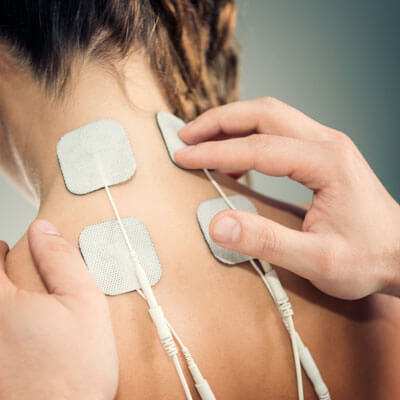 When you have muscle or joint pain, you often want to use every strategy you can to overcome your discomfort. One option for relieving muscle and joint pain is transcutaneous electrical nerve stimulation (TENS). TENS can be used alongside chiropractic care to help relieve your pain.
When you have muscle or joint pain, you often want to use every strategy you can to overcome your discomfort. One option for relieving muscle and joint pain is transcutaneous electrical nerve stimulation (TENS). TENS can be used alongside chiropractic care to help relieve your pain.
I have been a licensed chiropractor and spine care physician in Virginia for more than 20 years and I incorporate TENS into my chiropractic practice. In this article, I’ll explain how a TENS unit works, and how it can treat your pain.
FAQ’s
How Does a TENS Device Relieve Pain?
The effectiveness of the TENS unit is based on the gate control theory of pain. In this theory, the spinal cord controls a “gate” that can either let pain signals pass to the brain or block them. In general, pain signals from small nerve fibers are allowed to pass through to the brain. In contrast, pain signals from large nerve fibers are blocked by the gate.
TENS works by selectively stimulating large nerve fibers. This stimulation can reduce or cancel out other pain signals being transmitted from the area from small nerve fibers. As such, a TENS unit can electronically short-circuit the pain impulses that the body generates.
The controls on your TENS unit allow you to manipulate the electronic signal to your nerves to achieve gate theory. This includes being able to control:
- Pulse width (the width of the electronic impulse)
- Pulse rate (the speed of the electronic impulse)
- Intensity (strength of the electronic impulse)
You can also control the modes of the electronic pulses. These typically include:
- B=burst (a burst of electronic impulse)
- C=constant (a steady electronic impulse)
- M=mixed (a combination of burst and constant)
A TENS unit can be used for varying lengths of time. At first, it is usually recommended to use it up to four times a day for 20 to 30 minutes in mixed mode, with the pulse width and rate at a mid-range setting. The intensity setting should only be as high as you start to feel it. You should never be able to see the unit pulsing on your skin.
Once you get used to using your TENS unit, you can begin to experiment with the settings to see what is most effective for your pain.
That said, some people should avoid using TENS units. This includes people with a cardiac device like a pacemaker.
Further, some people might experience an allergic reaction or skin irritation with standard TENS electrodes. In this case, you should stop using regular electrodes and instead can use blue gel electrodes, which our office can provide.
What Parts Come in a TENS Unit?
- The TENS device itself, which usually comes with a warranty
- Electrodes, which can be used 10 to 20 times each on clean and dry skin, and need to be replaced when they stop sticking
- Lead wires from the TENS device to the electrodes
- Batteries. Each 9-volt battery generally gives up to 100 hours of use. Rechargeable batteries can also be used
How Do I Troubleshoot My TENS Unit?
If your TENS unit is not working as expected, there could be several different problems. Always consult the manufacturer’s instructions for your specific TENS unit make/model. However, many common TENS problems are easily solved, such as:
- The battery could be inserted incorrectly
- The battery might not be making contact against the terminal post. In this case, press the battery forward to see if the unit works, or if the indicator lights up.
- The lead wires might need replacement
- The lead wires might be stretched, wrapped, or coiled
Where On My Body Can I Use a TENS Unit?
You should not put the electrodes directly on the pain site, as the electrodes would transmit the electrical impulse through the painful area. Instead, the electrodes should be applied above, below, left, and right of the injury or painful site.
TENS Units and Precision Spinal Care
As a certified NUCCA chiropractor and spine care physician, I strongly believe that the first visit is best used as a time to fully assess your condition. This includes a thorough exam and a discussion about your medical problems.
After your exam at the first visit, we will discuss my evaluation. If a TENS unit is appropriate to treat your condition, I will advise you of this. I can write you a prescription for a TENS device, which can be provided directly from my office. I will also show you how to use it.
If chiropractic is not the best solution for your needs, I will recommend the type of specialist who is most appropriate for you.
If chiropractic care is the best way to meet your care goals, we will work together to develop a plan to meet your needs. I make sure to set reasonable expectations and milestones for your recovery. At regular intervals, I will reevaluate you to make sure you are meeting these goals and that chiropractic remains the best choice for you.
We understand that you need to explore all your options when you look for expert chiropractic care. At Precision Spinal Care, we are happy to help you determine the best way to address your specific needs and discuss all the options with you and your family. Call our office at (757) 382-5555 to speak with me or set up a consultation. You can also set up an appointment through our webpage.

